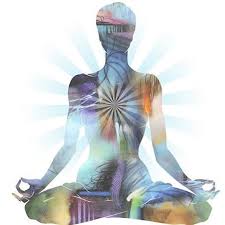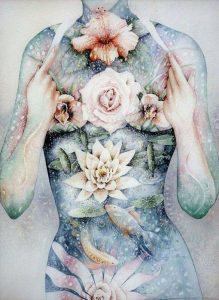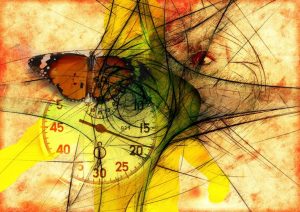 We had the second meeting of our Introduction to Meditation and Mindfulness series at Yoga Bliss today. The course content is adapted from the wonderful work of Insight Meditation teacher, Gil Fronsdal. Last week we focused on mindfulness of breathing. We use the breath to stabilize and center ourselves. We pay attention to how we pay attention. We learn to distinguish fully experiencing breathing from thinking about breathing or anything else. This week we open the lens of our attention to include the present moment experience of embodiment. Many of the best qualities of human being come through the experience of being embodied: intelligence, understanding, love, and compassion.
We had the second meeting of our Introduction to Meditation and Mindfulness series at Yoga Bliss today. The course content is adapted from the wonderful work of Insight Meditation teacher, Gil Fronsdal. Last week we focused on mindfulness of breathing. We use the breath to stabilize and center ourselves. We pay attention to how we pay attention. We learn to distinguish fully experiencing breathing from thinking about breathing or anything else. This week we open the lens of our attention to include the present moment experience of embodiment. Many of the best qualities of human being come through the experience of being embodied: intelligence, understanding, love, and compassion.
Embodiment & Meaning Making Stories
We use the breath to stabilize and center ourselves. We aim to feel our body breathing, naturally without technique. Only feeling breathing and our body’s experience expressed as sensation. Awareness of the body. Beyond awareness of the body, we experience emotions; beyond emotions we experience thought; beyond thought we experience mind. At the center of this constellation of aliveness is our breathing. When the center is full, it provides us stability. We can move outward, experience sensations, emotions and thoughts, while remaining grounded. We begin, again and again, by using the breath to stabilize and center ourselves.
 Today we focus on the body and the experience of physical embodiment. The body is always present. If we are connected to the body we are in the present moment. In mindfulness meditation, the very simple practice of noticing, we bring our attention to our living experience. If we are present with our breathing we are taking in the sensations of that experience in a deeper, fuller way. Like being on the beach on a nice sunny day. Imagine you’re on the edge of the ocean, standing there and taking in the breeze, the smell of the ocean, the sight. You really register the experience; you take it in. In the same way, you sit with your breath and take in the fullness of the experience of breathing in.
Today we focus on the body and the experience of physical embodiment. The body is always present. If we are connected to the body we are in the present moment. In mindfulness meditation, the very simple practice of noticing, we bring our attention to our living experience. If we are present with our breathing we are taking in the sensations of that experience in a deeper, fuller way. Like being on the beach on a nice sunny day. Imagine you’re on the edge of the ocean, standing there and taking in the breeze, the smell of the ocean, the sight. You really register the experience; you take it in. In the same way, you sit with your breath and take in the fullness of the experience of breathing in.
It’s easy to confuse mindfulness with commentary, judgment, or an evaluation of our experience – meaning making stories. The commentary colors and influences the experience. It affects the way we see people and the world. They become entangled in judgment. The same thing happens with regard to ourselves. Our inner dialog, whether critical or friendly, separates us from feeling our breathing fully. An important aspect of mindfulness meditation is learning to recognize the commenting, judging, evaluating mind and teasing it apart from the actual experience of feeling breathing. This is an essential ability in freeing ourselves: distinguishing between what is happening and our interpretation of what is happening. Distinguishing between direct experience and the meaning we assign to it. Our meaning making stories come between us and our awareness of feeling.
 Our meaning making stories aren’t the real picture. Notice the difference between feeling what’s happening and thinking about what’s happening. Mindfulness meditation is choosing to live in the full awareness of our experience. We make a choice in mindfulness meditation. We’re not trying to stop thinking. We choose not to live in our thoughts, not to be swept away by them. We choose to have a quiet awareness – as if we were gazing at the sunset at the beach – taking in the sunset as it actually happens. In mindfulness meditation we choose to have a quiet awareness of our body without comment or interpretation. This meditation instruction is simple; our body is ever present.
Our meaning making stories aren’t the real picture. Notice the difference between feeling what’s happening and thinking about what’s happening. Mindfulness meditation is choosing to live in the full awareness of our experience. We make a choice in mindfulness meditation. We’re not trying to stop thinking. We choose not to live in our thoughts, not to be swept away by them. We choose to have a quiet awareness – as if we were gazing at the sunset at the beach – taking in the sunset as it actually happens. In mindfulness meditation we choose to have a quiet awareness of our body without comment or interpretation. This meditation instruction is simple; our body is ever present.
Returning to the Bodies We Have Left
People are often disconnected from the actual experience of their bodies for a variety of reasons. Years of work requiring habitual thinking. Living in the virtual world of computer entertainment and information. History of past trauma that often seems to continue living in body sensations. Many of us need a slow training to reawaken or rediscover full experience of our bodies. The ability to sense what exists in the body becomes stronger and more heightened as we practice mindfulness meditation. Once again, we choose, we intend to pay attention in a way that we are fully aware of our bodily experience. Your body can be a tremendous support for the practice of attention and awareness. When you show up in your body, you can sense the fullness of being in your body and feel – “Here I am.” Solid, connected, rooted.
 Visualize yourself as a mountain. Your seat forms a broad, stable base with which you can feel grounded: Here. Now. Your mind might wander away to other times and other places. We don’t just come back and pay attention to here, but we come back and feel “here,” connected here, rooted here, present here, feeling our body here. It can be a slow process for many people, but over time with practice, you will probably find that your body will become more and more awake.
Visualize yourself as a mountain. Your seat forms a broad, stable base with which you can feel grounded: Here. Now. Your mind might wander away to other times and other places. We don’t just come back and pay attention to here, but we come back and feel “here,” connected here, rooted here, present here, feeling our body here. It can be a slow process for many people, but over time with practice, you will probably find that your body will become more and more awake.
Choosing What to Include
The usual instruction for mindfulness meditation recommends that you use the breathing as the center, the default. The point is not to live in your breathing all the time but to learn how to bring a wise, freeing, and liberating attention to all aspects of our lives. And the way we do this is by choosing to bring our attention to, and to center ourselves on, the breath. The emphasis is placed on the breathing until another experience becomes more compelling or more predominant. When another experience becomes more compelling, we let go of the breath and bring our silent attention to the more compelling experience. If a sensation in your body becomes stronger than the sensation of breathing, you can let go of the breath and let your attention settle into that more compelling physical experience in your body.
 The experience can be pleasant or unpleasant. When people first start meditating, they’re not used to holding their meditation posture. It can take awhile—some weeks, some months—for the body to adjust—where it’s not aligned, or it’s tight, or not strong enough. Again and again bring the attention to whatever is most compelling. Over time different things will speak up, different things will call for attention. Eventually, the full spectrum of what your life eventually reveals to you can become compelling. The things you need to look at and work through and to resolve will come up in their own time. You can be very relaxed. You don’t have to be in a hurry expecting things to happen. Over time, emotions come up, thoughts come up, body sensations come up. We can open up to the broader spectrum of what’s going on right here, right now.
The experience can be pleasant or unpleasant. When people first start meditating, they’re not used to holding their meditation posture. It can take awhile—some weeks, some months—for the body to adjust—where it’s not aligned, or it’s tight, or not strong enough. Again and again bring the attention to whatever is most compelling. Over time different things will speak up, different things will call for attention. Eventually, the full spectrum of what your life eventually reveals to you can become compelling. The things you need to look at and work through and to resolve will come up in their own time. You can be very relaxed. You don’t have to be in a hurry expecting things to happen. Over time, emotions come up, thoughts come up, body sensations come up. We can open up to the broader spectrum of what’s going on right here, right now.
Guided Meditation
You can find a summary of the 20 minute practice on the linked file: Guided Meditation on the Body. You can use this outline to help your daily sitting practice during the week.
Walking Meditation
We use silent walking meditation to widen the lens of our awareness to include movement. You can practice walking meditation to practice mindfulness throughout your day. Steven Smith, the guiding teacher of the Hawai’i Insight Meditation Center, has provided this delightful set of Walking Meditation Instructions.
Closing Remarks & Homework
During your daily practice this week notice when the body becomes more compelling or more predominant than your breathing and just let go of your breathing. Let your attention center itself on that part of your body with the strong sensation. And again, separate out the commentary and just stay with the immediacy of your experience. You can find a summary of homework suggestions on the linked file: Introduction to Meditation Mindfulness of the Body Homework.
Mindfulness can be trained on anything. This week we’re training with strong sensation in the body. If there’s an idea that this strong sensation shouldn’t be there, that’s commentary. You don’t have to get involved in the commentary. You develop tremendous personal power by learning how not to get swept away by your thoughts. Re-enter the world of sensations in your body. It can be helpful to label them using mental notes. So if you feel an itch, name it, “itch, itch.” Stay with the simplicity of the itch.
Discomfort & Pain
 Some sensations may be uncomfortable; there might be pain. Pain is very interesting. Researchers of pain have found out that pain is not a singular, unitary thing; it’s a composite. The experience of pain is made up of many signals that come together. Together they make the notion of pain. Sometimes there are associations, memories, meaning-making, projection, fear, or anxiety that accompany the signal. We’re encouraged to be present for pain and to tease apart the commentary, the judgments, the reactions, and the emotions from the pain itself. Many people find that when they can do that, the struggle with pain lessens.
Some sensations may be uncomfortable; there might be pain. Pain is very interesting. Researchers of pain have found out that pain is not a singular, unitary thing; it’s a composite. The experience of pain is made up of many signals that come together. Together they make the notion of pain. Sometimes there are associations, memories, meaning-making, projection, fear, or anxiety that accompany the signal. We’re encouraged to be present for pain and to tease apart the commentary, the judgments, the reactions, and the emotions from the pain itself. Many people find that when they can do that, the struggle with pain lessens.
A new world opens up to many experiences when you drop below the commentary and concepts you have about them. So if you relate to pain as just pain, you are probably relating through a concept, and all the associations you have to that concept. But if you experience the sensations, they may still be uncomfortable, but the experience might be more one of burning, pressure, tension, tingling and a variety of particular sensations. The same thing is true for pleasant experiences.
No More Distractions
 We also consider sounds as physical sensations. We don’t treat sounds as intrusions in our mindfulness meditation. Sounds are yet another experience to be folded into the field of our awareness. We’re not locking onto one thing; we’re ready to open the awareness to what is happening. So if a sound becomes predominant, then we do sound meditation. If your neighbor’s dog is barking, you don’t have to be angry—thinking, “That’s disturbing my meditation!” The dog barking becomes your meditation. What we do then is turn the attention to the listening— “hearing, hearing.” We take in the vibration, the sense, the feelings, the whole experience of listening to the dog barking.
We also consider sounds as physical sensations. We don’t treat sounds as intrusions in our mindfulness meditation. Sounds are yet another experience to be folded into the field of our awareness. We’re not locking onto one thing; we’re ready to open the awareness to what is happening. So if a sound becomes predominant, then we do sound meditation. If your neighbor’s dog is barking, you don’t have to be angry—thinking, “That’s disturbing my meditation!” The dog barking becomes your meditation. What we do then is turn the attention to the listening— “hearing, hearing.” We take in the vibration, the sense, the feelings, the whole experience of listening to the dog barking.
Keep It Simple: Breath, Body & Sound
Try to stay with your breath. If a strong sensation arises in your body that is more compelling than your breath, then let go of the breath and turn to that. If strong, compelling sounds arise, be relaxed, include those sounds as sound meditation. Every time you take in something new, every time you say “Oh that’s compelling, let me take that in,” try to see if you can meet that experience with a sense of ease, and relaxation.
Over time this practice becomes a wonderful process of self discovery. Not only do you discover yourself, but more importantly, you discover how to be free of yourself. And as you’re free of yourself you’re more free to be yourself, in a fuller, more complete way. And then eventually, if you follow this path long enough, your sense of self falls away, and that’s a wonderful feeling, just to be present without self consciousness.
